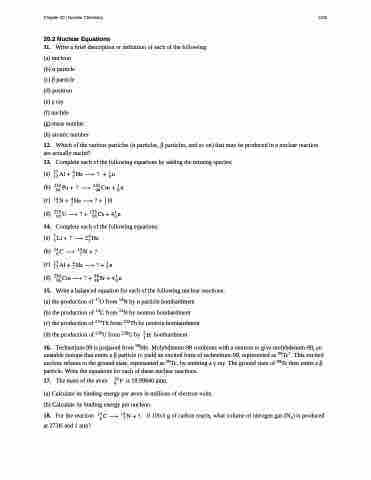Page 1165 - Chemistry--atom first
P. 1165
Chapter 20 | Nuclear Chemistry 1155
20.2 Nuclear Equations
11. Write a brief description or definition of each of the following:
(a) nucleon
(b) α particle
(c) β particle
(d) positron
(e) γ ray
(f) nuclide
(g) mass number (h) atomic number
12. Which of the various particles (α particles, β particles, and so on) that may be produced in a nuclear reaction are actually nuclei?
13.
(a)
(b)
(c)
(d)
14.
(a) (b) (c) (d)
15.
(a) (b) (c) (d)
Complete each of the following equations by adding the missing species:
��������� � ��� ��� �
��� �� � � � ��� �� � � � �� ���
������������ ���
���� � �� ��������� �� �� �
Complete each of the following equations:
������������
�� � � �� � � � ��
����� ��� � �� �� ��� �
����� � �� �������� �� �� �
Write a balanced equation for each of the following nuclear reactions: the production of 17O from 14N by α particle bombardment
the production of 14C from 14N by neutron bombardment
the production of 233Th from 232Th by neutron bombardment
the production of 239U from 238U by �� � bombardment
Technetium-99 is prepared from 98Mo. Molybdenum-98 combines with a neutron to give molybdenum-99, an unstable isotope that emits a β particle to yield an excited form of technetium-99, represented as 99Tc*. This excited nucleus relaxes to the ground state, represented as 99Tc, by emitting a γ ray. The ground state of 99Tc then emits a β particle. Write the equations for each of these nuclear reactions.
17. The mass of the atom ��� � is 18.99840 amu.
(a) Calculate its binding energy per atom in millions of electron volts.
(b) Calculate its binding energy per nucleon.
18. For the reaction �� � � �� � � �� if 100.0 g of carbon reacts, what volume of nitrogen gas (N2) is produced
at 273K and 1 atm?
16.
��


